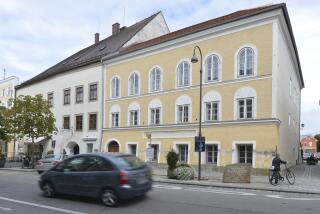Lost-art database unveiled
- Share via
VIENNA — Holocaust survivors and their heirs now have a powerful new tool to look for art and other belongings looted by the Nazis in Austria.
It’s an online database of thousands of objects -- such as paintings, books, medals, photographs, furniture, jewelry and sculptures -- that may have been expropriated from 1938 to 1945, when the Alpine country was a part of Nazi Germany.
The items are now in museums and collections owned by the Austrian government or the city of Vienna. The origin of most are still in question, and it remains to be determined if they were in fact looted.
The database -- launched this month and accessible at www.kunstrestitution.at -- is the latest such tool to help locate art from the Nazi era. It was put together by the National Fund of the Republic of Austria for Victims of National Socialism in cooperation with museums and special commissions that trace the origins of artwork obtained lost during Nazi rule.
The fund is required by law to auction off items for which no owners or heirs are found and distribute the proceeds to Nazi victims. No deadline has yet been set for processing claims.
Descriptions of about 7,500 objects have been entered into the database so far, and by year’s end it will probably balloon to about 10,000, with more to be added as research results come in, project leader Michael R. Seidinger said.
Specifics about each item are accompanied by a digital photograph. But to date, only about 500 pictures have been uploaded, Seidinger said.
“It’s definitely a work in progress,” he added.
Such initiatives are not new. Germany launched www.lostart.de in 2000 to help Holocaust survivors track down stolen art. In Britain, auction houses, art trade associations, insurance companies and art researchers collaborated in 1991 to establish www.artloss.com to register and recover stolen art, the majority from the Holocaust. And the London-based Central Registry operates www.lootedart.com. The Czech Republic also displays museum objects formerly owned by Czech Jews online at www.restitution-art.cz and has extended the deadline for claims until the end of the year.
However, Hannah Lessing, the fund’s secretary-general, claims Austria is the first to have developed an online database of “such complexity.”
Seidinger said users could get access to preliminary research results that would be updated regularly, adding that the database was created after extensive negotiations between representatives of the fund, museums, commissions and Vienna’s Jewish community.
Earlier this year, Austria handed over five paintings by Gustav Klimt to Maria Altmann of Los Angeles and other family members following a seven-year legal battle.
An arbitration court had ruled that they were improperly seized when the Nazis took over the country.
Austria’s decision to give up those artworks, which had been displayed for decades, represents the costliest concession since it began returning art stolen by the Nazis.
It’s unlikely that anything so valuable is included in the database, but there are undoubtedly items of considerable interest listed.
More to Read
The biggest entertainment stories
Get our big stories about Hollywood, film, television, music, arts, culture and more right in your inbox as soon as they publish.
You may occasionally receive promotional content from the Los Angeles Times.










